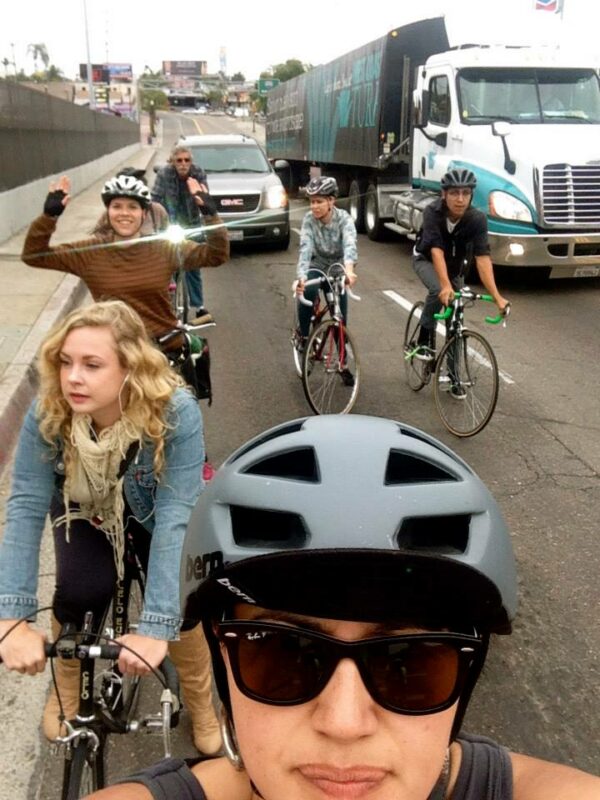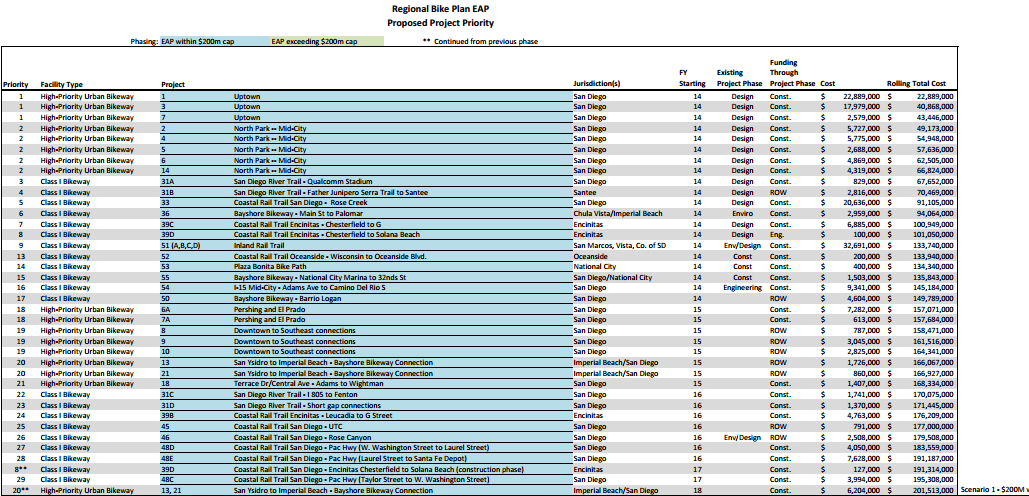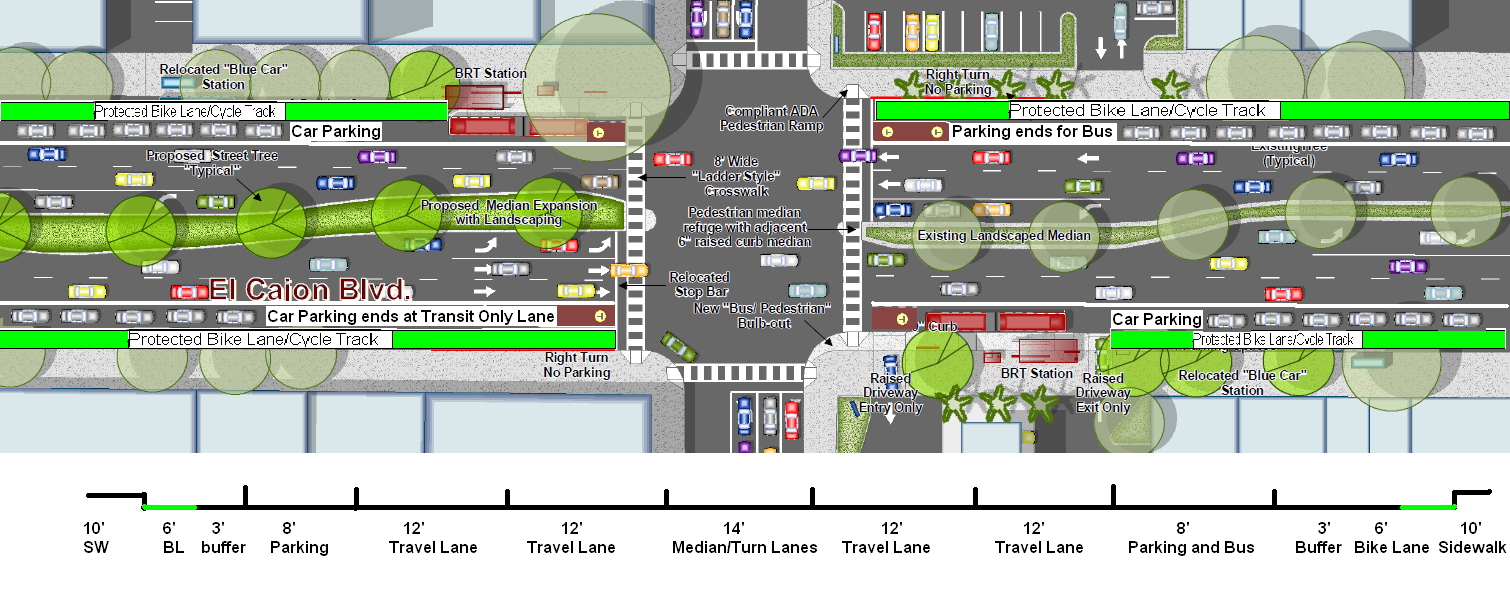Foto Friday: San Diego's Bike Train

Mid-City now has a bike train thanks to the pioneering efforts of two women, Veronica Medina and Sandra Pimentel, who were recently featured in the Uptown News.
Uptown News' Morgan Hurley writes,
As a main corridor of Uptown, University Avenue runs approximately 10 miles from La Mesa in East County to Mission Hills, and has long been deemed an unsafe roadway for bicyclists. Until the proposed changes regarding bicycle infrastructure along University Avenue take place, commuters either tough it out or find alternative routes to make their way across town.
With Bike Train, an alternative now exists.
“There is a need for people to feel safe when they are commuting,” Medina said. “We’ve been asked, ‘Why University? Can we go on Howard … or Orange?’ We made a decision; we want to be visible and we want to have the most direct route to get to wherever we need to go instead of going out of our way and feel safe doing so.”
Safety in numbers is the concept that the San Diego Bike Train is implementing, and this is a relationship first articulated in 1949 by Reuben Jacob Smeed. This relationship is now known as Smeed's Law, now a truism. In 2003, this truism was further detailed in the British Medical Journal in a paper titled "Safety in numbers: more walkers and bicyclists, safer walking and bicycling" which concluded,
A motorist is less likely to collide with a person walking and bicycling if more people walk or bicycle. Policies that increase the numbers of people walking and bicycling appear to be an effective route to improving the safety of people walking and bicycling.
Today the Netherlands is exalted for their high percentage of bicycling rates. But the road to a safer and more livable communities came at the cost of many lives lost and a long hard fight to obtain and created dedicated safe spaces for people.
While we work to transform San Diego into a city that allows us all to travel on our roads without fear of bodily harm or death, two women are creating temporary safe places to travel on two wheels along University Avenue. Below is a video that will give you an idea of what to expect and the amount of work needed to change our city's streescape. For more information or to just jump aboard the train, visit their Facebook page to learn more.
Tomorrow: SANDAG Transportation Committee to Vote on Early Action Projects
Tomorrow we have the first of two big meeting on our hands. SANDAG's Transportation Committee will vote to approve the SANDAG's staff Early Action Project Program along with Scenario 1 as the preferred implementation option.
Scenario 1 allows for $200 million to be used toward the Early Action Projects which include both the Uptown and the Mid-City bike corridor projects within the next decade - a good thing.
The meeting will be held at the SANDAG offices located at:
401 B Street, 7th Floor
San Diego, CA
Below is an image showing all the projects that will be funded with Scenario 1 (click for bigger version)

In 2011 the Board of Directors made a commitment to Active Transportation with the adoption of the 2050 Regional Transportation Plan and its Sustainable Communities Strategy, which included integration of Riding to 2050: San Diego Regional Bicycle Plan (Bike Plan) previously approved by the Board of Directors in 2010. The final action by the Board included the development of a Bike Plan Early Action Program (EAP) for the projects included in the Bike Plan. In April 2012, the Transportation Committee accepted the goals of the EAP framework and approved funding to conduct preliminary engineering work and refine construction cost estimates. These estimates have been used to prepare funding scenarios and implementation options. The Transportation Committee is asked to recommend that the Board of Directors approve the Regional Bike Plan Early Action Program with Scenario 1 as the preferred implementation option
The list of members who sit on the Transportation Committee, chaired by San Diego's interim mayor Todd Gloria, are available at this link. No matter where you live in the county, your support is needed. Show up in person to offer a testimonial and ask the committee to vote on the approving Scenario 1 or email your elected official asking them to do the same.
Next Friday, September 27th - the full SANDAG board will vote on the Early Action Projects. So if you are unable to make it out tomorrow in person, please make it a point to show up on the 27th.
The Case for Protected Bike Lanes (aka Cycle Tracks) on El Cajon Boulevard
As part of SANDAG's Early Action Plan (projects to be implemented within the next decade), the design of two regional bike projects scheduled to be implemented in the City of San Diego are already underway.
Given the resounding support from the first North Park-Mid-City meeting for peaceful, neighborhood greenways and efficient, connected cycletracks, we're proposing a design idea of what El Cajon Boulevard could look like if a protected bike lane (cycle track) was implemented along the entire length of El Cajon Boulevard.

The above rendering shows the protected bike lane protected by parked cars, a design that has currently been implemented with great success in Long Beach, CA.
Why should the bicycle riders be protected by parked cars? To quote Jan Gehl, a Danish architect and urban design consultant based in Copenhagen, this design allows "parked cars to protect the bicycles instead of the bicyclists protecting the parked cars." The focus should be on keeping people safe from harm. This design has been implemented elsewhere in the country and is also a part of the NACTO Urban Bikeway Design Guide - a guide we want the city to adopt so that planning for bicycle use can move away from the highway design manuals that is currently in effect and instead use guidelines specific to bicycle usage.
The SANDAG Early Action Project has specific objectives that we believe will be met with the implementation of protected bike lanes. The objectives are:
- Implementing the Regional Bicycle Network (part of the Regional Bicycle Plan): Implementing the network will add life to the street, will transform El Cajon Boulevard to be more attractive to people who currently do not ride and will accommodate the future transit project.
- Street Parking Remains - This will grow business by bringing more people to the Boulevard rather than moving auto traffic through the neighborhood.
As for neighborhood greenways where through vehicle traffic is discouraged? We don't see our proposal as being an either/or proposition. We proposed both protected bike lanes on El Cajon Boulevard, and neighborhood greenways (bicycle boulevards) along parallel streets like Howard Avenue or Meade Avenue. People who want to get places need multiple options. Just like San Diegans currently have a choice in driving on the I-8, SR-94 or on University Avenue and El Cajon Boulevard to traverse the east/west corridors, bicycle riders also should be offered the ability and option to get to their destinations along routes designed with them in mind. Forcing riders to contend with high speed traffic or relegating them to dimly lit residential streets is not the way forward, not the way to make San Diego a world-class bicycling city.
Don't forget to attend tonight's Mid-City/North Park Community Advisory Group Meeting. Details are below.
6 p.m. - 8:30 p.m.
Sunset Temple
3911 Kansas Street
San Diego, CA 92104
Update: It seems that some of our supporters were concerned about how the design would deal riders wanting to ride across intersections. We've been documenting some of the best treatments for intersections here as part of our "Foto Friday" series which includes the ideal, and some interim measures which include separate traffic lights to ensure all users can get through safely.
